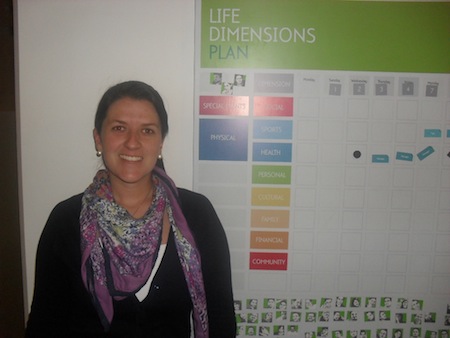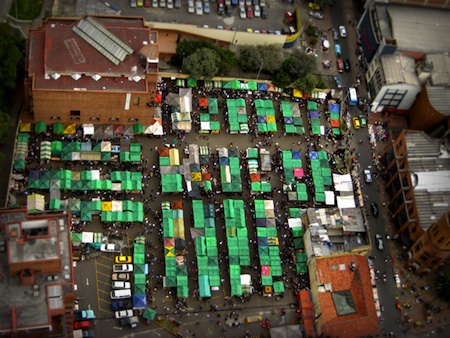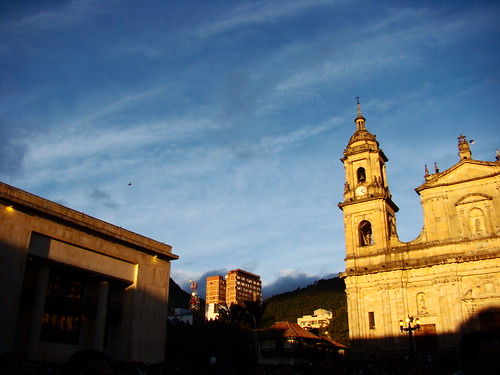At Zemoga, we know that no matter the medium you may use in your professional work, inspiration can come from anywhere and take any form.
Month: March 2011
La Bonga del Sinú

by Ricardo Garcia
If you are steak and BBQ lover, “La Bonga del Sinú” is the place to be! Discover the secrets of Montería’s multicultural valley through this restaurant that amazingly recreates the Costeño(1) environment!
The original restaurant lies in Monteria, Cordoba, a small city near Colombia’s Pacific coast. The Sinú River flows through the city, stroking the Malecón(2), inspiring painters and poets alike. In the heart of this magical place, a huge Bonga tree shades the large, picturesque wooded house that is the restaurant … this is where the name and the history begin.
Now, fast-forward to the gorgeous Bonga located in the core of Bogota, surrounded by the coppery-green Andes and lit by the modern lights of the city. The landscape may have changed but the tradition lingers. Visit Bonga and you will find an awesome menu, confident that no dish will disappoint. This is the right place to try a “weirdo” plate with an unpronounceable name, something you’ve never seen or heard of before, brimming with traditional “comida costeña”. When you have first arrived, and are barely settled at your table, the waitress brings you platanitos(3) with suero. Oh, dear! This sweet and sour white cream is so good you will want to buy tons of it to mix and spread with even the most unimaginable meals.
La Bonga is, definitely, the place to eat a great steak and grab a beer while enjoying the idiosyncrasy of Colombia. So grab a bottle of rum and surround yourself with the sweet sound of Porro music (interpreted by great talents like: Banda Bajera de san pelayo, Juancho Torres y su orquesta, Banda 19 de Marzo , lucho Bermudez, Pedro laza y sus pelayeros, banda juvenile de chocho, Banda de laguneta) and stunning paintings of fruteras(4), Maria Mulatas(5) and Gabriel García Marquez. Sheltered by this Bonga, straight from the banks of the Sinú, you will discover the hidden memory of a place you will always want to visit: Montería, the enchanting colony of the Coast!
—
Footnotes:
(1) Costeño: A Person who live´s in the coast of Colombia.
(2) Malecón: is a word used in Spanish-speaking countries for a stone-built embankment or esplanade along a waterfront.
(3) Platanitos: go and type it on google images.
(4) Fruteras: picturesque afro-colombian women who strut along beaches selling fruit they carry atop beautiful hats.
(5) Maria Mulatas: Typical character of the carribean coast
MEET THE INTERNS: Sana
1. What school do you go to and what do you study?
I am a senior in the Design and Management BBA program at Parsons School for Design.
Why Your Company Needs A Tech Policy
by J. Vegerano
The efficiency of a company’s information technology depends directly on the individuals that implement, configure, troubleshoot, manage and operate the technology infrastructure on a day-to-day basis. The company’s tech policies and procedures are the foundation of efficient technology operations and understanding.
Postcard Winners: Green Rooftops
Photo by Rodrigo Bernal
Taken: with a Canon Power Shot. It was then processed in Photoshop for some color and contrast.
Follow Me: Using Twitter and Technology to Save Lives
Follow Me: Using Twitter and Technology to Save Lives
In case you missed it, our fearless leader, Zemoga founder and CEO DJ Edgerton gave a presentation at South by Southwest Interactive, on Monday, March 14th. Check out the slides from his presentation
Thinking Better On Bogota
by Briana Campbell (@MsMatchGirl)
Last night, while looking at Facebook, I saw a link to a post on Tourist Attitude, by Mario Chamorro (formerly of Bogota, now of Boston, MA) and I thought I would share it with you.
MEET THE Z-TEAM: Maria

1. Without using any of the words in your job title, can you explain what you do for Zemoga?
The main goal of my job is to have happy and motivated people! I promote social activities within the team and their families, as well as well-being services, compensation, benefits, training and fun events. And everything I do falls under our most valuable program: Life Dimensions!
I work with an
Digital Outlook: How Technology is Changing the Magazine Publishing Industry

By Sven Larsen (@zemoga)
What’s next for magazines? As the digital agency of record for Rodale and as periodical industry partners for over two decades, it’s a question that is both personally and professionally compelling to myself and a lot of the team members at Zemoga.
With the recent merger of Zemoga client THE DAILY BEAST and industry stalwart NEWSWEEK, it would seem like the ties between the digital and print media worlds are getting closer and closer. And with the continuing double digit declines in traditional publishing revenues you would think that magazines would be rushing to embrace the new channels and technologies that could bring them the next generation of readers. But with the exception of a notable few like Bonnier and Condé Nast, publishers have been slow to embrace the online and mobile worlds.
Why is that? Certainly, smart phones are not an optimal platform for consuming magazine content. But the introduction of the iPad last year and the stunning projections for tablet sales in 2011 and beyond surely address the issue of distribution and optimized devices, right? Still magazines are dragging their feet, especially when it comes to mobile development.
To understand their reticence, we have to understand that the challenge for magazine publishers is much bigger than their book publishing brethren. For the book publisher, the switch to digital is akin to the emergence of the paperback book in the 1930’s. Kindle versions and the like can be seen as yet another new format, one that actually comes without a lot of the headaches of traditional print production. And while there may be haggling about author royalties and revenue shares, the fundamental business model remains the same … profits are generated by single copy sales of the product.
For magazine publishers, however, single copy sales are the least significant part of their revenue stream. A typical magazine will distribute their single copies to newsstands on a returnable basis and count themselves lucky if 25-30% of the print run is actually sold (ironically called the magazine’s efficiency rate). With a discount of anywhere from 40-60% to retailers and wholesalers, it’s easy to see how single copy sales can actually be a money losing proposition for a publisher. The advent of tablet computers is actually a boon for single copy sales. Not only can publishers get rid of the wasteful “Print 4 to sell 1” model, they can also retain a larger share of revenue by distributing through Apple rather than a complex series of intermediaries. So protecting the revenue from single copy sales is not a motivating factor in magazine publishers’ reluctance to embrace digital.
Subscriptions are a trickier business. Recently, both Apple and Google announced new subscription models for their respective app stores. The Google model takes a 10% revenue share and allows the publisher to control pricing. The Apple model is much more restrictive, taking their standard iTunes 30% revenue share and forbidding publishers to sell digital subs at a lower price elsewhere.
Apple’s model has had magazine publishers up in arms with complaints about the size of the companies rev share. But this is actually a paper tiger as well. Traditionally, companies don’t make money off of actual subscription sales. Acquisition costs are high (that football phone you get with SPORTS ILLUSTRATED isn’t cheap), retention costs are even higher (think about how many subscription expiry reminders you get in the mail) and traditional resellers like Publisher’s Clearing House take a much bigger piece of the pie than Apple is requesting. But publishers have always been tolerant of making marginal revenue on subscriptions because it allows them to claim larger ratebases (which in turn allows them to charge advertisers and “list purchasers” more money)
The issue publisher’s really have with Apple’s model (as David Carr clearly identifies in this NEW YORK TIMES article) is that Apple does not share user data on sub purchases. So the publisher has to request this information directly from the subscriber. And very few of us really want to share that information with a publishing house that is going to turn around and sell that data to other companies. So exit one of the few ways traditional publishers make money.
That leaves us with the real source of magazine publisher’s revenue, advertising sales. Advertising is traditionally sold on a cost per thousand basis (“cpm”). The higher your ratebase, the higher and ad can be sold for. So magazine publishers do everything they can to get that number up. They may sell subscriptions for a penny (although the Audit Bureau of Circulation has cracked down on this practice in recent years) or 90% off cover price. They may give you a phone or a tote bag or another expensive piece of swag to get you to subscribe. They may claim that copies are “passed along” so that an ad has more impressions. It’s a pure numbers game, that is based on anecdotal and representative data. Magazines conduct extensive and expensive surveys to profile their readership. But these surveys only touch upon a cross section of readership. For advertisers, magazine display advertising has always been untrackable, with no clear picture on the actual number of impressions or what kind of consumers actually viewed the ad.
Digital changes all that. The consumption and impact of digital display ads (like every other piece of digital content) can be easily measured. Their increased functionality also allows for a greater understanding of how consumers are interacting with the marketing message too. There is no unmeasurable “pass along readership” of a digital edition an
Postcard Winners: Parque el Virrey

Photo by Carlos Agudo
This photo was taken with a Sony DSC-S60.
‘Parque el Virrey’ is one of the most beautiful places in the city, it is very quiet but there is also a lot going on. People go there to exercise, bike, run or do some yoga.
This park is one of Carlos’ favorite places. It has a lot of green in it and you can breathe in peace. However, when you just turn your head around what you will see is people rushing everywhere. When you are in the park, it feels that time stops, allowing you to realize what surrounds you, and your inner self.
This photo belongs to a series that Carlos took waking up very early on Sundays, the idea was not to have people in the photos, emulating Eugene Atget’s work. In this type of photo, architecture stands allowing the viewer to feel proximity with the space.
Fun facts about Parque el Virrey:
During July, ‘Alimentarte’ takes place in this park. ‘Alimentarte’ is a gastronomy festival. It brings together the best of local and international food.
In December, Parque el Virrey is visited by locals and tourists because of its lights and Christmas decoration





